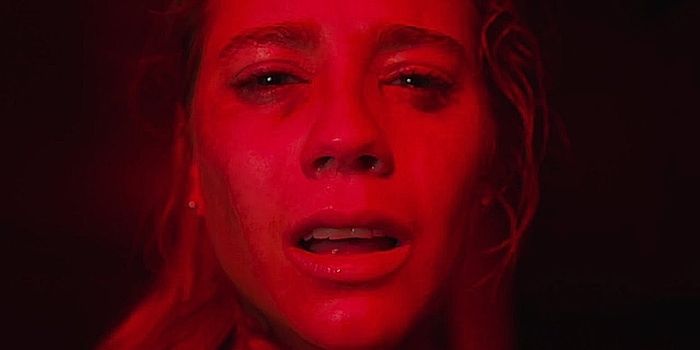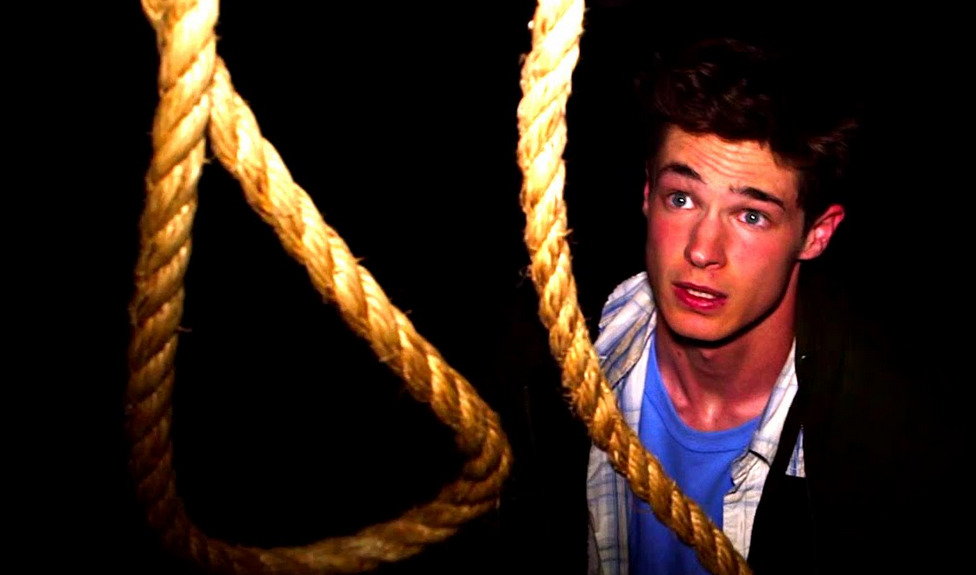Scary.
For the third time this year* I’m faced with the very real dilemma of whether to discard my instincts when it comes to film appraisal and recommend a film that could be considered to be objectively poor. Perhaps the problem lies in the question of what makes a film successful, if success is a term that should characterise art. Further complicating my impasse is the very real possibility that not all film is art and indeed that not all film ought to be measured and regarded with one unifying attitude. The Gallows, a found-footage horror film by Travis Cluff and Chris Lofing, fails in many distinctions that generally denote a film’s quality. But then, I spent so much of the film hiding in fear behind my trusty puffy jacket that the success of the film’s ambitions in relation to the reaction that it elicited in me is impossible to deny.
The first consideration worth noting regarding my response to The Gallows is that I’m exceptionally easy to startle and I appeared to be one of the very few reviewers in the screening that I attended that was audibly affected by the film (with the exception of one welcome comrade to my right, whose heavy breathing hopefully drowned out my groans of dismay every time I detected an imminent startle.) The second consideration is that every creative field in which a film is customarily judged – narrative, dialogue, cinematography, acting etc. – were entirely void of merit and originality in Cluff and Lofing’s film. If you’ve seen a horror film or a found footage film then you’ve seen The Gallows. It’s the same, but worse.
What’s remarkable about found footage films, aside from the fact that it’s grown into a widely accepted and produced form of cinema, is that they theoretically ought to make a film experience more realistic and yet by engaging in absolute impossibilities and relying on unlikelihoods, the suspension of disbelief that an audience is forced to employ is more drastic. Nobody would persist with the filming that these characters do. It’s not just The Gallows that fails to address this fundamental problem with this breed of film.
But found footage filmmakers are growing increasingly disinterested in considering and exploiting the restrictions and the possibilities that come with the conventions of these films. A notable exception is Unfriended, a film released earlier this year that played out entirely on a computer screen. Whereas in Unfriended the found footage concept augmented the film’s themes and the nature of the format was ingeniously manipulated, there’s the distinct sense with The Gallows that the stylistic devise was employed because of budgetary restraints, and then largely ignored. It’s entirely unnecessary, distracting and poorly executed.
The narrative is neither compelling nor significant. It’s 1993, at the Beatrice High School performance of “The Gallows.” Tragedy hits the play when the lead actor is unintentionally hanged in front of the audience and his co-stars; a disaster the result of a faulty prop. Twenty years later and Beatrice High is revisiting the play for the first time since the accident, with shy footballer Reese Houser (Reese Mishler) and theatre enthusiast Pfeifer Ross (Pfeifer Brown) as the two leads. Houser is having doubts about his abilities as a leading man, so his friend Ryan Shoos (Ryan Shoos…yep) convinces him that it’s a good idea to break into the school theatre in the middle of the night and destroy the sets. Up until this point, my puffy jacket had remained firmly over the part of my body to which jackets normally pertain. It wasn’t scary, it was just bad.
But Cluff and Lofing appreciate the inherent spookiness that clings to theatres. They are eerie places, perhaps because of all the hidden areas behind and below a stage, perhaps because an empty theatre is so unsettlingly lonely with the ghosts of performance past or perhaps because by its very nature, theatre is, like cinema, all about deception. Beyond this appreciation, the filmmakers barely handle their filmic environment in a way that equals its potential, although that might have been a byproduct of the disorienting camerawork that always accompanies these found footage films.
And yet regardless of the emptiness of thought or filmmaking aptitude, The Gallows turned me into a shell of my former self. For the duration of much of its running time, I wanted the experience to be over; not because of all the problems that I’ve mentioned in this review but because I just couldn’t handle watching what might happen to these characters. It’s worth mentioning that what might have happened to the characters often didn’t, but the imagination is a powerful ally of a filmmaker with a zeal for jump scares. It’s impossible for me to say whether these scares were earned or cheap startle techniques and it’s exceedingly possible that I was scared to an equivalent degree by a housemate jumping out at me while I was making breakfast this past weekend. There will no doubt be horror enthusiasts who will laugh off the stale thrills that The Gallows has to offer. Perhaps they ought to spare a thought for the puffy jacket wearing film critics curled up in a ball in the Jam Factory cinemas Gold Class at 10:30am on a Monday morning.
*for those interested, the other two films were Chappie and San Andreas.
6/10
For more Reviews, click here. If you’re digging ReelGood, sign up to our mailing list for exclusive content, early reviews and chances to win big!

